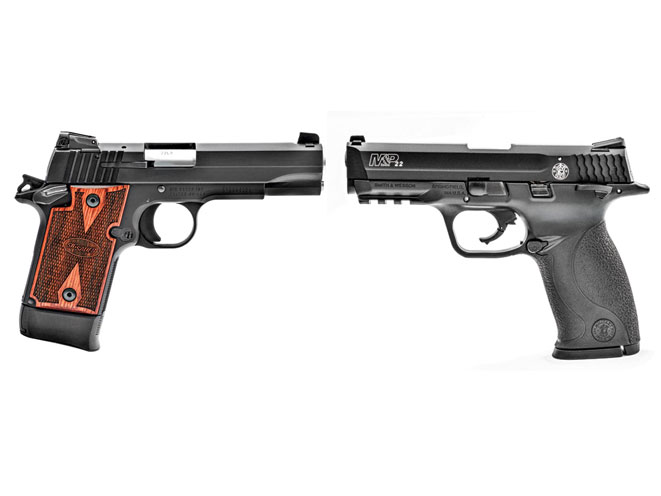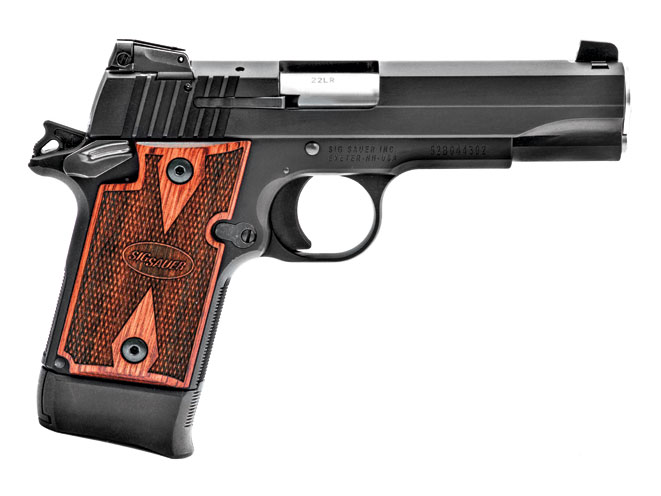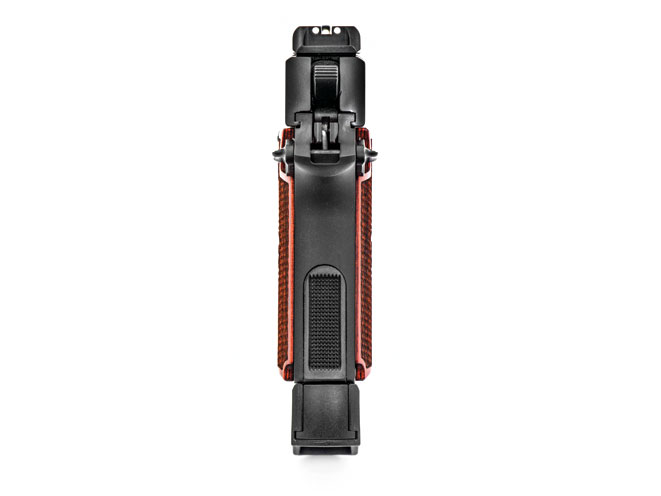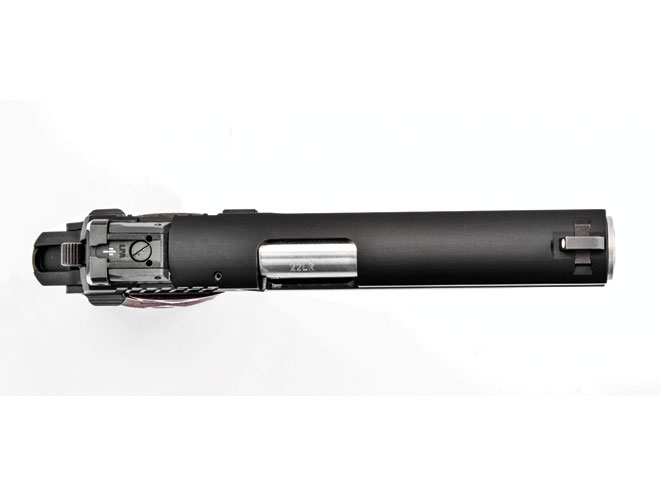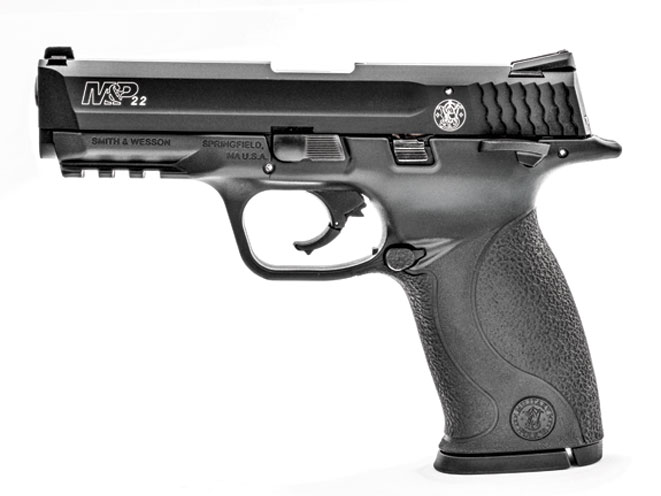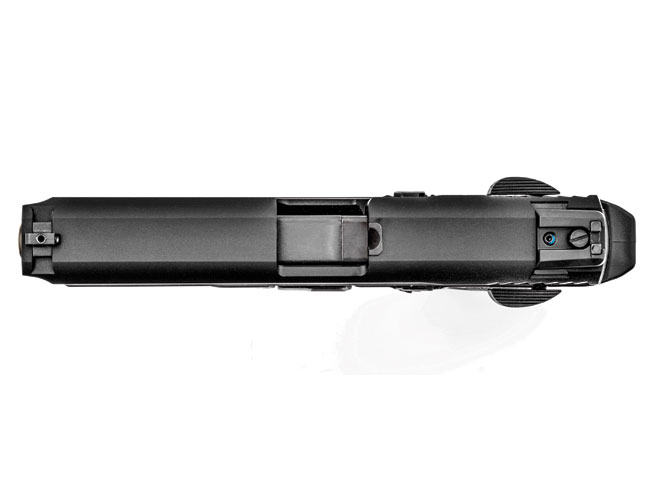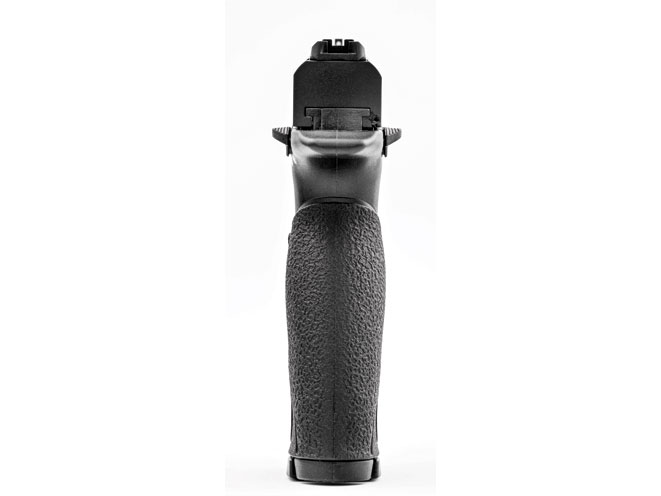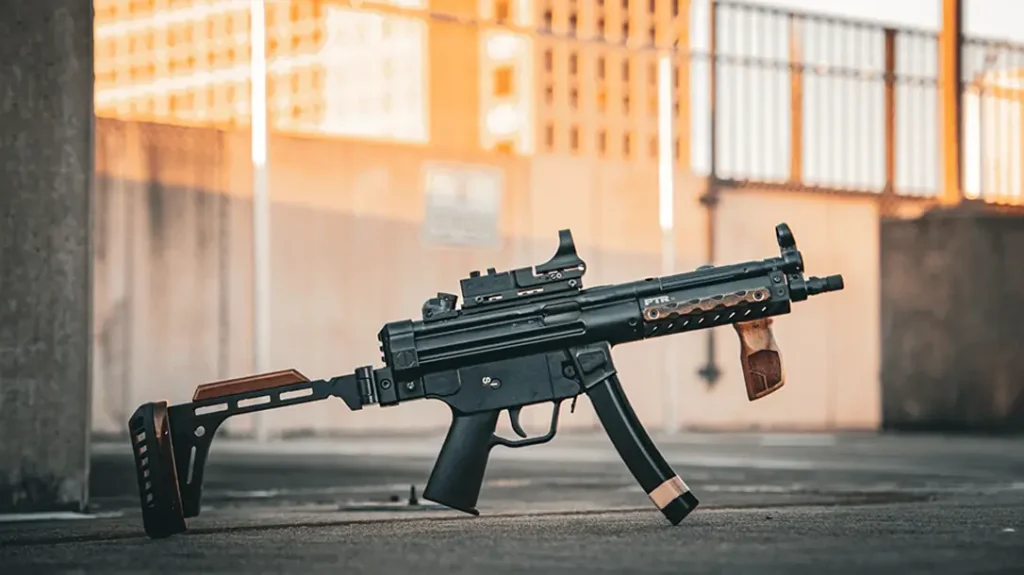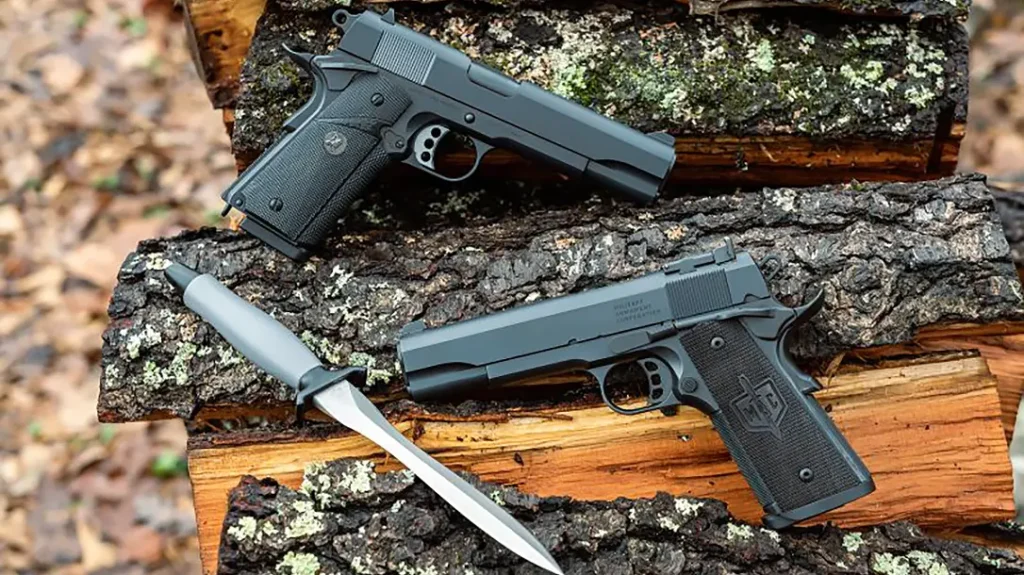From plinking to plugging bad guys, the .22 LR has had a distinguished, albeit sometimes shady, history. It all began late in 1943 when William J. Donovan, director of the OSS (Office of Strategic Services and World War II predecessor to the CIA), arrived at the White House for a meeting with President Franklin D. Roosevelt. Led into the Oval Office, Donavan waited while FDR finished dictating a letter. He then turned his back on the president and placed a sandbag on a couch across the room and drew a suppressed High Standard HDM .22 LR pistol, which he proceeded to empty into the sandbag as Roosevelt finished his message.
Oblivious to the muffled .22’s operation, the president greeted Donavan, who handed him the still-smoking, suppressed semi-automatic and explained exactly what he had just done. The astonished president, himself no stranger to firearms, was immediately all ears as his OSS director detailed a pending request for a new type of semi-auto for use in the field by a select number of agents who carried out special operations around the world.
During the war, these agents were armed with everything from 1911s to the .25 ACP Baby Brownings, but Donovan wanted the silenced .22s. After meeting some resistance to his request, he determined that the decision to approve the new guns for the OSS would have to come from no one less than the president. The OSS got its High Standard semi-autos in January 1944.
Advertisement — Continue Reading Below
Despite its size, a .22 round is a very effective means of preserving one’s survival in a life-threatening encounter. The .22 also has a long history of use in firearms training, and many traditional, full-sized semi-autos like the Colt Model 1911A1 and other historic firearms have been manufactured in .22 LR for that purpose. Detailed and accurate duplicates of larger-caliber weapons in .22 LR have a proven track record, and these latest models from Smith & Wesson and Sig Sauer are ideally suited to square off in a “Tale of the Tape” shootout.
Sig Sauer P938-22

If you know Sig Sauer models, you know that the P938 is a subcompact 9mm semi-auto, not a .22 LR. The P938-22 is the exact same gun chambered down to .22 LR, with a slide, bull barrel, full-length guide rod and magazine conversion produced by Sig Sauer and offered as the standalone model P938-22 shown or as a conversion kit ($349) for the 9mm model. There are two .22-caliber P938 models currently available, one with the Nitron-finished slide, 3.3-inch bull barrel and 10-round magazine and the Target version shown, with a 4.1-inch “long slide” featuring adjustable contrast sights and an increased sight radius.
Advertisement — Continue Reading Below
While the 9mm P938 packs 6+1 capacity into the lightweight, alloy-framed pistol, the .22 LR variant carries 10+1. The cocked-and-locked design and single-action trigger give either the 9mm or .22 LR excellent handling for a pistol this size, and fans of the 1911 will also find the ambidextrous thumb safety, magazine release, and slide-stop lever are in very familiar places.
RELATED STORY: Gun Review – Sig Sauer’s P229 Legion Pistol
The ambidextrous safety makes the gun suitable for both left- and right-handed shooters. The thumb safety allows the slide to be pulled to the rear, even in the “safe” position, to check for a loaded chamber, to clear the gun or to chamber a round, without taking it off “safe” (so long as the hammer is cocked). In the .22 configuration, however, the slide will not release on an empty magazine, nor will it lock back fully after the last round is fired due to design requirements for 9mm use. Thus the slide has to be pulled back to the stop before releasing an empty magazine.
Advertisement — Continue Reading Below
The polished bull barrel has the same exterior dimension as a 9mm barrel with the bore sleeved down to .22 LR, and the gun uses a full-length, polished steel guide rod and a flat recoil spring. The P938-22 is a full-feature Sig pistol, not a .22 LR copy like some, and it feels exactly like the 9mm version right up to the moment you pull the trigger. As with the 9mm version, there is no magazine disconnect, so the .22 will fire a chambered round with the magazine removed. While a bit pricey for a .22 pistol at $719, it is about the best built subcompact .22-caliber handgun you can buy. If you already have a P938, the complete .22 conversion sells for $302, or $352 for the long-slide variant. Finally, the P938-22’s reduced report and recoil make it a great first handgun for new shooters who want to start out with a top-quality firearm. (http://www.sigsauer.com; 866-345-6744)
Smith & Wesson M&P22

Although it also has a 4.1-inch barrel, the S&W .22 LR is a somewhat larger handgun overall compared to the Sig. There is a Compact version available with a 3.56-inch barrel and overall length of 6.65 inches, but for comparison with the Target-model Sig, the standard S&W is the more comparable gun. Priced at $419, the M&P22 has the same fit in the hand, heft, balance and general operating features of the 9mm M&P, and thus like the Sig is an excellent trainer with a couple of minor exceptions. Namely, the .22 M&P uses a fixed barrel and a blowback action as opposed to the 9mm’s locked-breech design. And the .22 does not offer interchangeable backstraps. On the plus side, overall length is the same, as are width, height and weight as a 9mm, 4.25-inch-barreled M&P. The .22 variant has the same ambi slide-stop release, thumb safety and reversible mag release, making it fully ambidextrous. The front sight is a drift-adjustable white dot and the rear a fully adjustable, low-profile, black, combat-style sight.
Advertisement — Continue Reading Below
RELATED STORY: Smith & Wesson’s Performance Center M&P R8 Pistol
The M&P22 feels right in the hand, caliber notwithstanding, while the Sig, being a subcompact by design, feels less substantial, although it is exactly the same as its 9mm brother. The M&P is a larger handgun overall, averaging 0.5 inches more in length and height, 0.38 inches more in width and is best suited to holster carry, whereas the narrower, shorter and overall smaller and lighter Sig can fit nicely into a pocket holster.
The S&W22 is available in 10+1 and 12+1 versions, and it has the same polymer frame with metal inserts as the 9mm version, as well as a Picatinny rail on the frame’s dust cover, making the .22 suitable for tactical lights and laser training applications. The Sig, in either .22 or 9mm, does not incorporate an accessory rail. The Sig uses a steel slide (like the 9mm M&P) while the S&W .22 LR has a lighter-weight, aluminum-alloy slide like all .22s made by Umarex, which builds the .22 LR models for Smith & Wesson, thus the M&P .22 is an American gun made in Germany and the Sig P938-22 a German gun made in the U.S. (http://www.smith-wesson.com; 800-331-0852)
Advertisement — Continue Reading Below
Rimfire Showdown
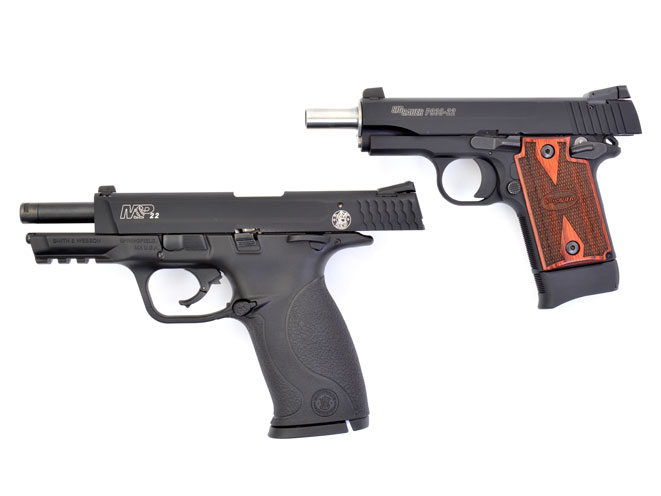
Both .22s are single-action-only designs, the M&P with a nicely articulated safety trigger and the Sig a 1911-style design with a deeply serrated front edge. These two triggers are about as different in design as conceivable and both excellent in their mode of operation. Trigger pull on the M&P averaged 6.1 pounds, while the Sig Sauer P938-22 averaged 7.9 pounds. The Sig has a remarkably short 0.187 inches of take-up to release, zero overtravel and a quick reset. The S&W’s trigger is a leggy 0.75 inches for the first shot, with a quick reset and a shortened follow-up pull of 0.25 inches, since a full release of the trigger is not necessary to reset. One other point about the S&W, it has a magazine disconnect and will not fire a chambered round with the magazine removed.
Advertisement — Continue Reading Below
With 4.1-inch barrels, the range test was done from 15 yards and fired off-hand using three popular .22 LR rounds: Federal’s Target Grade 40-grain round nose, CCI’s Tactical 40-grain copper-plated round nose and Winchester’s Super-X 40-grain round nose. With both pistols having the same barrel length, velocity differed from a low of 952 fps to a high of 987 fps. Federal clocked 972 fps in the S&W and 987 fps in the Sig. CCI cleared the traps at 958 fps in the S&W and 952 fps from the Sig. And Winchester Super-X traveled downrange at 972 and 890 fps, respectively.
RELATED STORY: Concealed Carry Comparison – Steyr M40-A1 vs. HK VP40
The ambient temperature was a crisp 34 degrees Fahrenheit (which does affect velocity) and winds were gusting from 10 to 15 mph. The best five-round groups averaged 1.5 inches with the Sig and 1.75 inches with the S&W. Neither gun is going to win a gold medal in competition, but between the two the S&W is the easiest to load and shoot. The Sig is a little slower to operate but a bit more accurate with far superior sights. (Change the rear sight on the 4.1-inch-barreled S&W to the white-dot rear available on the Compact and you have it all).
Advertisement — Continue Reading Below
The ambidextrous features and slide operation of the S&W give it an edge over the P938-22 in speed of handling, and overall it is a slightly more comfortable pistol to hold. The big difference between the Sig and the S&W, however, is that the Sig is a real P938 chambered in .22 LR, while the S&W M&P22 is a dedicated .22 LR pistol. If you already own a Sig Sauer P938 as a CCW or want it both ways, the .22 conversion option is hard to beat for the money. As a straight up .22 however, the tale of this tape is that the S&W measures up.
